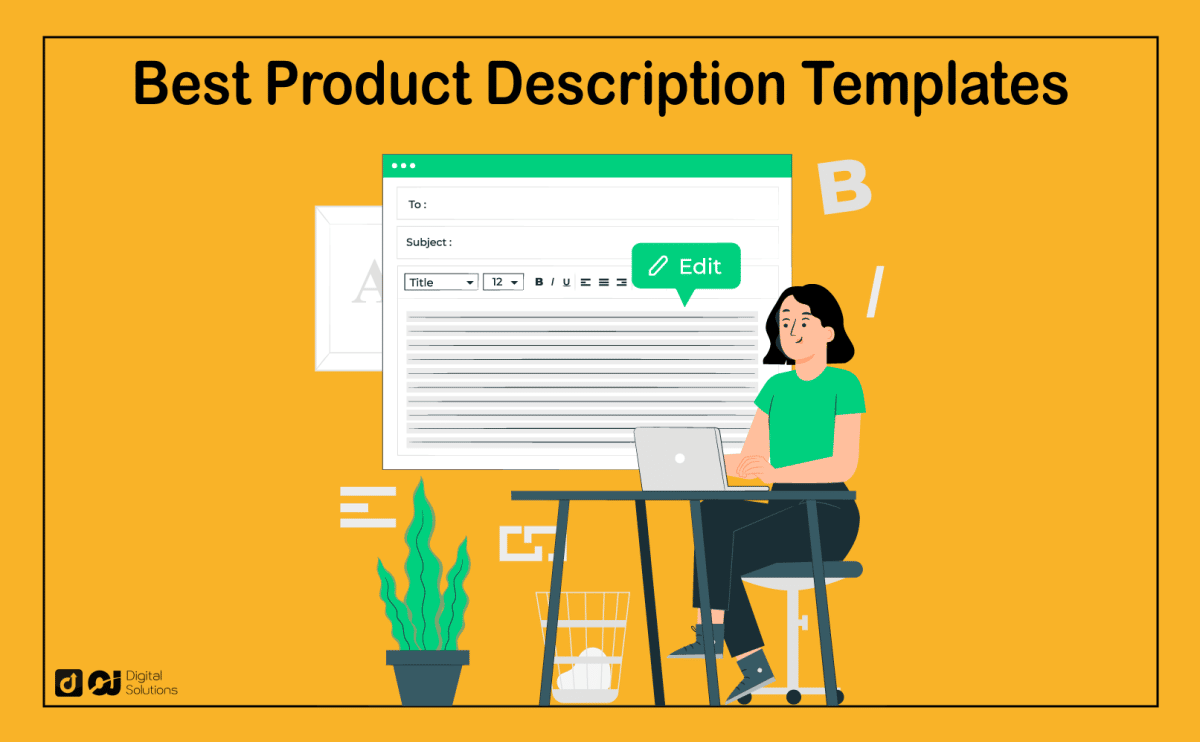Looking for product description templates to end your struggle to write a compelling copy?
This guide is your ticket.
I’ve been there, spending hours trying to find the right words to captivate customers. But I’ve soon learned it’s all about capturing your product’s essence and determining how it can solve your ideal customer’s pain points.
By sharing the structured approach that transformed my clients’ sales, I’ll guide you through crafting powerful, enticing product narratives.
Let’s begin.
5 Best Product Description Templates + Examples
Here are the five best product description templates you can use as inspiration.
1- General Product Description Template for Product Pages.
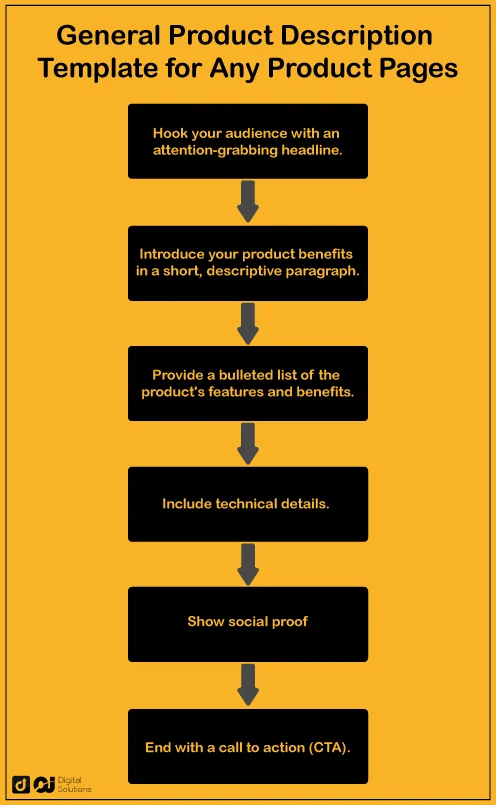
Here’s an editable template you can start with:
[Attention-Grabbing Headline]
[Start with a short, engaging paragraph that introduces the product and its primary benefits. Highlight the product’s value proposition.]
Features and Benefits:
- [Feature 1]: [Focus on how it can benefit the user.]
- [Feature 2]: [Focus on how it can benefit the user.]
- [Feature 3]: [Focus on how it can benefit the user.]
Technical Details:
- Dimensions
- Weight
- Material
- Compatibility
[Social Proof]
[Include testimonials, user reviews, ratings or any form of social proof that supports the quality and effectiveness of the product.]
Example: “The [product] has truly made a difference in my [specific use]. Highly recommended.” – [Customer name]
[Call to Action]
[Encourage the reader to take a specific action, such as to buy now or sign up for a trial.]
Example: “Experience the difference today! Click here to [Buy/Discover/Learn More].”
You can customize this template for nearly any product, but ensure you highlight your brand’s personality, use clear and descriptive language, and write for your ideal customer.
2- Beauty and Personal Care
Focus on the effects and benefits of your product. Some other nice features, such as smell and texture, are just a bonus.
Here’s an editable template for beauty and personal care products:
[Product Description]
[Incorporate sensory adjectives to create a sense of urgency or need.
Highlight relevant features such as being vegan, organic, paraben-free, etc.]
Directions:
[Describe the best way to use the product. This section is a great place to suggest related products.]
Example: For best results, use [product] with [another product].
Features and Benefits:
- [Feature 1]: [Focus on how it can benefit the user.]
- [Feature 2]: [Focus on how it can benefit the user.]
- [Feature 3]: [Focus on how it can benefit the user.]
Ingredients:
[Make sure to list the ingredients as per the current laws and regulations. If you’re in the US, the FDA has a Cosmetics Labeling Guide to help you.]
Specifications
- Volume
- Amount
- Weight
- Other Important Details
[Social Proof]
[Include testimonials, user reviews, ratings or any form of social proof that supports the quality and effectiveness of the product.]
Example: “Been using this every night and it only took one week to notice a difference.” – [Customer name]
Let me give you a prime example of a good product description in this niche.
Dr. Squatch is a high-quality brand of personal care products selling men’s soaps, deodorants, and body washes.
I’ll break down Dr. Squatch’s product descriptions for their Pine Tar soap.
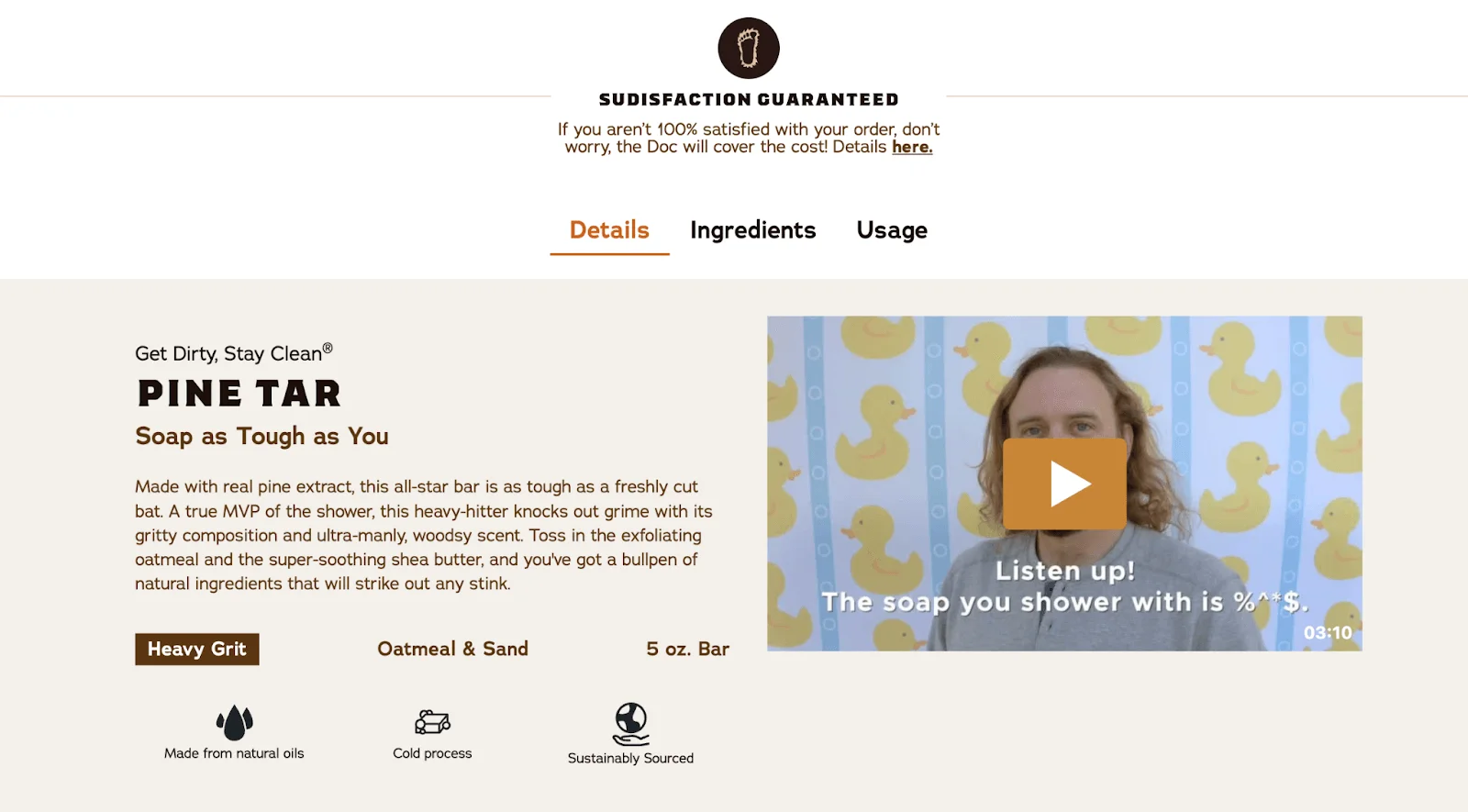
- Product Description or Overview – it uses an intimate, friendly, and inviting tone. It also includes relevant features that can serve as value propositions or unique selling points (ex., vegan, 100% organic, paraben-free).
- Directions – Dr. Squatch’s steps are simple: “Lather It Up, Scrub Yourself, Rinse & Repeat.”
- Benefits – using mixed sensory adjectives, Dr. Squatch explains the benefits of the soap ingredients.
- Ingredients – Dr. Squatch is transparent about the ingredients used in this particular product.
- Customer Reviews – the product page also has social proof at the bottom, showing a lot of satisfied customers.
3- Food and Beverage
Writing product descriptions for food and beverages can be tricky because you’ll have to accurately convey the flavors, texture, and other sensations your customers can expect.
That’s why we’ll rely on sensory words to engage the brain.
Let me share an editable template for food and beverage products.
[Product Name]
[Utilize sensory adjectives to describe the beverage, such as creamy, decadent, sweet and tangy.
Incorporate sensory experiences related to taste, sound, and texture (e.g., crunchy, soft).] [Include the product’s benefits, especially if it aligns with health-conscious attributes or indulgent treats.]
[Sub-Heading: this can be a tagline or phrase that highlights the main feature.]
[List four or five crucial characteristics such as vegan, dairy-free, soy-free, gluten-free, non-GMO to attract health-conscious or eco-friendly consumers.
Add certified labels and trust badges that match these characteristics (e.g., USDA Organic, Certified Kosher, Non-GMO Project Verified)
However, avoid adding unverified claims.]
Weight or Volume:
[Specify the weight for dry products or volume for liquid items. Clarify if the product is a bundle of single-serve containers or individually-packaged items.]
Ingredients:
[Make sure to list the ingredients according to the current laws and regulations. Check FDA’s website for more details.]
Nutritional Facts:
[List common nutritional elements like Protein, Total Fat, etc.]
[Social Proof]
[Include testimonials, user reviews, ratings or any form of social proof that supports the quality and effectiveness of the product.]
Example: “Can’t get enough of this product!” – [Customer name]
Here’s a great example of a product description from the chocolate maker Green & Black’s.
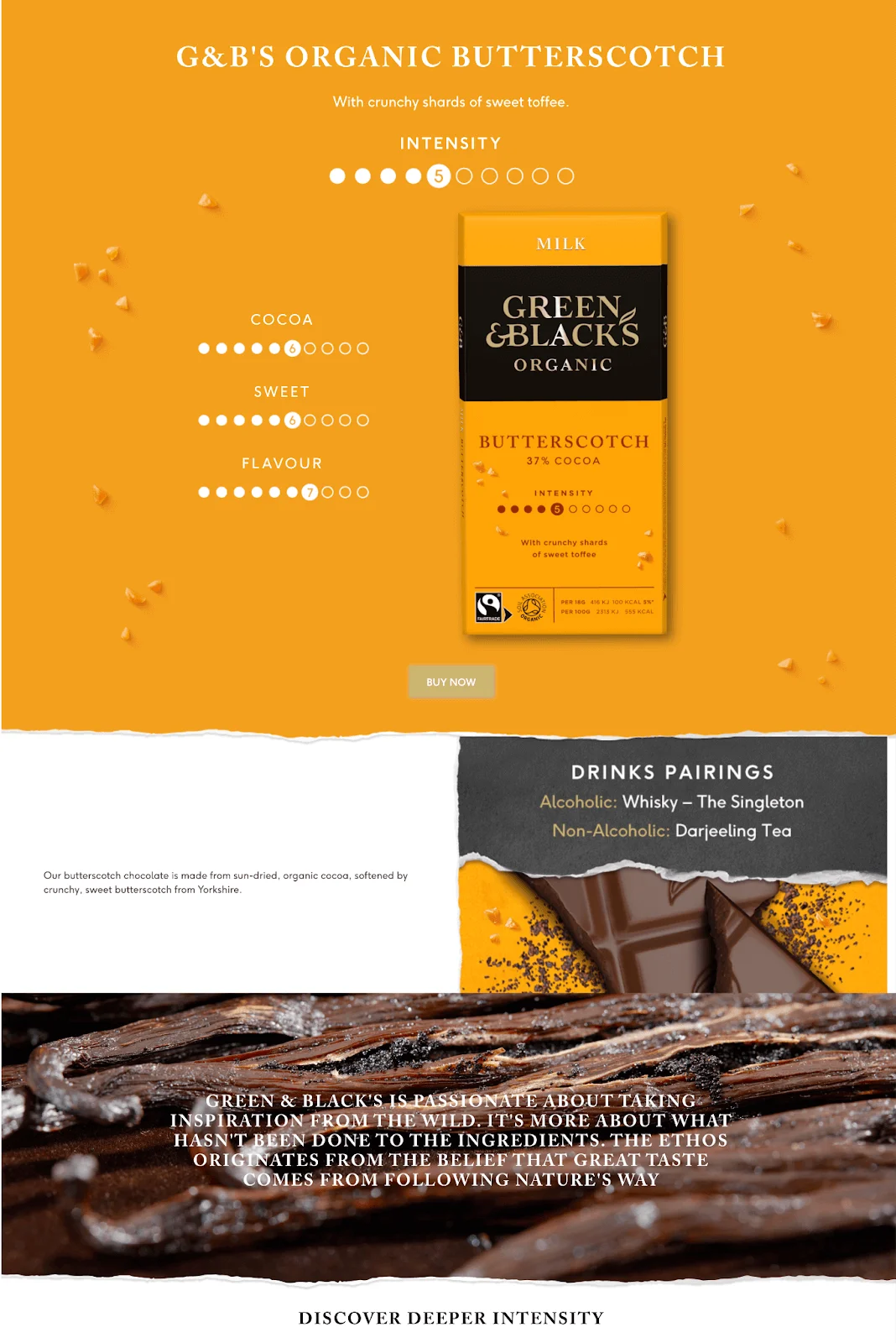
- Images – the product page showcases various close-up shots of the chocolate, showing how delectable and inviting it is.
- Product Description or Overview – besides taste, Green & Black’s sensory adjectives involve sound and touch, like “crunchy” and “soft.”
- Product Characteristics – Green & Black’s used power words to describe their chocolate, appealing to certain consumers.
4- Clothing and Apparel
Many products are self-explanatory. However, some people still want to read a brief production description for items like clothes and apparel.
Here’s how you can write product descriptions for clothing and apparel:
[Images]
[Include multiple high-resolution images showcasing the following:
- Various angles of the product and the model wearing it
- Close-ups of the fabric, seams, and texture
- Shots of footwear bottoms
- Colors and patterns available
- Related products to complete an outfit
[Video]
[This section is optional, but it can help increase your conversions by providing a more intimate look of the apparel.]
[Product Description or Overview]
[Utilize sensory adjectives to appeal to the consumer’s sense of style. Describe the benefits of the clothing, especially if it’s functional (e.g., rugged construction, warmth, waterproof fabric).
Incorporate the needs of the target market, emphasizing comfort, tailored sizes, and unique design features.]
[Sub-Heading: this can be a tagline or phrase that highlights the main feature.]
[Highlight key selling points, such as a supportive fit, reinforced stitching, etc. This can be in bullet points.]
Specifications:
- Manufacturing location (e.g., Made in China, Made in the USA, etc.)
- Metric measurements (inches, centimeters, or millimeters)
- Materials used (e.g., cotton, Gore-Tex, Neoprene, wool, etc.)
- Available colors or patterns
Sizes:
[Include a size guide to help customers understand the fit. Include all applicable measurements (e.g. waist, shoulders, length) for all sizes available (e.g. S, M, L, XL).]
Returns and Refunds:
[Explain the return or refund policy. Specify details, especially if returns are not allowed without tags or under certain conditions.]
[Social Proof]
[Include customer reviews describing color, fit, durability, and texture. These testimonials can significantly influence potential buyers.]
Example: “The sizes are accurate. I ordered small and it fits me well.” – [Customer name]
An excellent example is Bonobos’s shirts.

- Images – Bonobos shows multiple angles of the shirt, including a few close-ups, so you can better assess the clothing’s fit and texture.
- Product Description or Overview – Bonobos uses the needs of its target market by offering comfort, tailored sizes, and original design features.
- Color – they clearly displayed the variants available, including swatches of the fabric.
5- Electronics, Appliances, and Tech
Product descriptions in this category emphasize the technical aspects of the product.
However, that doesn’t mean you shouldn’t take this chance to attract customers with a powerful description.
Check out this formula:
[Images]
[Include multiple high-resolution images showcasing the following:
- Various angles of the product and the model wearing it
- Close-ups of the fabric, seams, and texture
- Shots of footwear bottoms
- Colors and patterns available
- Related products to complete an outfit]
[Video]
[This section is optional, but it’s the perfect way to showcase how your product works.]
[Product Description or Overview]
[Emphasize how the product benefits the consumer. Use action verbs to highlight its impact, such as boosting productivity or enhancing creativity. Maintain an authoritative yet informative tone.]
[Sub-Heading: this can be a tagline or phrase that highlights the main feature.]
[Highlight key selling points, such as a supportive fit, reinforced stitching, etc. This can be in bullet points.]
Specifications:
- Size
- Capacity
- Power in watts
- Other technical specs
[Be as detailed and technical in this section, offering exact specifications.]
[Main Features]
[List essential features in a non-technical list, focusing on innovative and cutting-edge attributes of the product.]
Warranty:
[Explain the return or warranty policy to guide customers on procedures if issues arise with the product.]
FAQs
[This section is optional, but I highly recommend it so you can address common queries.]
[Social Proof]
[Include customer reviews describing their experience with the product and how it benefited them.]
Example: “It’s easy to operate, and now I don’t have to scramble for meals every night!” – [Customer name]
Let me use the Instant Pot as a product description example.
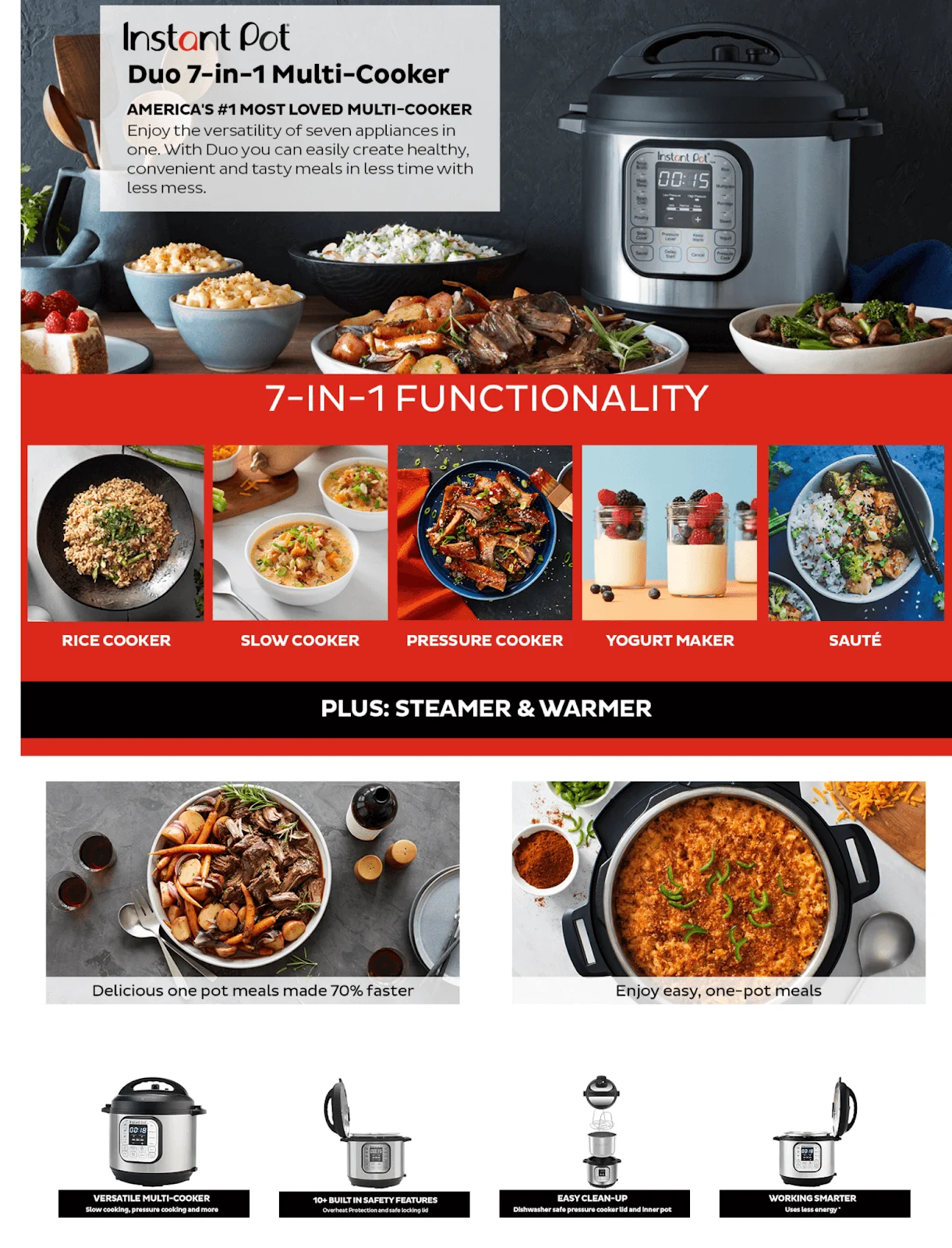
These are some of the elements I personally liked:
- Images – you can see the product in use in different settings, giving you ideas of how you can use it.
- Product Description or Overview – the page clearly highlighted the product’s functions and benefits.
- Product Information – the technical details are complete, allowing you to accurately assess if it fits your needs and your home’s electrical specifications.
Why Is a Product Description Important?
A product description serves multiple important functions for both sellers and consumers.
Primarily, it acts as a comprehensive source of information for potential buyers, offering details about the product’s features, specifications, and benefits, enabling informed purchasing decisions.
That aside, a description also offers other benefits in these areas:
- Sales conversion
A well-crafted product description can influence a customer’s buying decision. By highlighting the product’s unique features and benefits, it can lead to increased sales and conversion rates. - SEO and visibility
By incorporating important keywords, you can improve your product’s visibility in search results. - Brand representation
It’s an opportunity for brands to convey their voice, tone, and values. A well-written product description aligns with the brand’s identity and messaging, enhancing brand perception. - Competitive advantage
A unique, engaging, and informative product description can differentiate a product from competitors and highlight its distinctive selling points. - Building trust
Detailed product descriptions, including accurate information, customer reviews, and transparent policies, build trust between the seller and the buyer.
How To Write Product Descriptions That Sell
Here are seven tips for writing product descriptions to boost your sales.
- Identify Your Ideal Buyer.
The best way to write product descriptions is to understand your audience’s preferences.
Writing a product description that targets all buyer groups without specificity won’t address any particular audience. The best product descriptions start by understanding the buyer and then articulating the specifications.
You talk to them like you’re having a conversation. Address your target audience directly using the pronoun YOU.
Write product descriptions for your own ecommerce business by imagining your ideal customer.
- Does your target audience appreciate any humor?
- Are they using specific words?
- Do they hate certain words?
- Do they have questions you need to answer?
- How would you speak to your ideal buyer in-store if you were selling your product face-to-face?
Using appropriate language on your ecommerce site will help you have more meaningful conversations online.
- Create a Mental Picture.
A study found that 88% of shoppers value detailed product content.
Simply listing technical specifications isn’t enough.
List all necessary product details, then explain each feature’s benefit to the customer. Use descriptive and vivid language to create imagery and describe the experience of using your product.
- Attract Customers With Benefits.
When you sell products, especially your own products, you spend plenty of time discussing their specifications and features.
Potential buyers are more interested in knowing how a product can help them. Address the pain points and problems your product solves.
- Develop a Strategic Format.
People only read 16% of the content on a web page, so maximizing your time with customers is ideal.
As most people like to skim-read, it’s important to write compelling yet easily understandable product descriptions.
Improve your conversion rates by trying these formatting tricks.
- Use bullet points to create scannable lists.
- Include high-quality, eye-catching product photos.
- Break up blocks of text with product titles, headings, and subheadings containing power words.
- Use short paragraphs.
- Enlarge your font for easier reading.
- Leave plenty of white space on the page.
- Place lengthy technical details on another tab.
- Measure Product Description Success with Goals and KPIs.
Measuring the success of product descriptions requires goals.
You’ll see various benefits when you know how to write product descriptions that sell, such as:
- Lower return rates
- Increased conversion rates
- Reduced cart abandonment
- A boost in organic search rankings
- A decrease in calls from online shoppers
Tip: You can find countless product description examples on platforms like Amazon, BigCommerce, and Shopify.
- Optimize Your Product Descriptions for Search Engines.
Power words are vital for swaying your audience and SEO.
According to Amazon, using specific keywords will boost your search rankings. If you sell on the platform, it will help to learn how to rank high.
Improve your online store’s search engine optimization (SEO) by adding important keywords to the following:
- ALT tags
- Page titles
- Meta descriptions
- The body content of a page
Incorporate keywords naturally and avoid excessive repetition in your product descriptions. Add target keywords to make your product description or blog successful.
Your brand voice should also be present in every aspect of your online marketing, such as social media, SEO, and paid search.
Compelling, unique, and SEO-optimized copy makes your products more relevant to search engines and other digital marketing channels.
- Leverage Social Proof to Lure Shoppers.
Reviews and testimonials increase conversions on sales pages by 34%, as shoppers often seek suggestions when uncertain about purchase decisions.
They will naturally lean towards products with many positive reviews or testimonials.
Incorporate social proof by showcasing customer testimonials and a social media feed with user-generated content.
People also like buying popular items, so show off the best-selling products on your ecommerce website.
The Bottom Line
I hope my guide has shown you why a compelling product description pays off. Feel free to use and adjust the templates for your specific use.
Encourage people to buy from your ecommerce store by following the tips and product description examples I mentioned.

